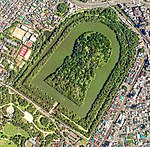Inaridai Kofun Group
Findings
The cluster includes Inaridai Kofun No. 1 Kofun, which is the kofun the Inaridai Sword was taken from. Some of the earliest pottery in the Kantō region has been found in this Kofun, giving its name to the type.
Location
Located on the west of the Bōsō Peninsula and just east of Tokyo, Inaridai is part of a concentration of early archaeological sites, which also includes Shakujii, in Tokyo's Nerima ward among others. Northeast of these locations are the later sites, categorized as Proto-Jomon. These Proto-Jomon sites are distinguished by pottery that predominantly features fiber or cord impressions.
In the Miura Peninsula, pottery has shell marks. In the Western Kanto Plain, pottery changed from fiber marks to cord marks. Inaridai is a key site in this change.
Usage in periodization
The Kofun cluster gives its name to Inaridai pottery, the oldest pottery type in the Kantō region.
The Inaridai No. 1 Kofun and the Inaridai Kofun group are found in the Kanto loam layer. This layer has both early Jomon pottery types like Inaridai, Haijima, and Tado I and other artifacts. It is also used as a categorization for figurines. and other implements.
In the Kanto valley of Japan, the Inaridai is some of the oldest pottery found. It has a special rolling marking on it. Experts aren't sure where this marking method came from. Wu thinks it might have started as a useful feature before becoming just for decoration. The Inaridai pottery dates back to just after the start of the proto-Jomon period. This makes it important for studying early Japanese pottery.
See also
- Proto-Jomon period
- Miura Peninsula
- Hashihaka Kofun
- Makimuku ruins
- Ukikunden
- Inariyama Kofun
- Furuichi Kofun Cluster
References
- ^ Kidder, J. Edward (1952). "Review of The Prehistory of Japan". Artibus Asiae. 15 (3): 288–292. doi:10.2307/3248573. ISSN 0004-3648.
- ^ Pearson, Richard (1990). "Review of Protohistoric Yamato: Archaeology of the First Japanese State". Harvard Journal of Asiatic Studies. 50 (2): 768–775. doi:10.2307/2719219. ISSN 0073-0548.
- ^ Kidder, J. Edward (1954). "A Reconsideration of the "Pre-Pottery" Culture of Japan". Artibus Asiae. 17 (2): 135–143. doi:10.2307/3249085. ISSN 0004-3648.
- ^ Maringer, J.; Kidder, J. Edward (1957). "Review of The Jomon Pottery of Japan, J. Edward Kidder, Jr". Artibus Asiae. 20 (2/3): 206–207. doi:10.2307/3249384. ISSN 0004-3648.
- ^ Yampolsky, Philip (1951). "Review of Historical Studies in Japan, 1949". The Far Eastern Quarterly. 10 (4): 392–396. doi:10.2307/2049017. ISSN 0363-6917.
- ^ Tamburello, Adolfo (1962). "Review of Japan Before Buddhism Italian edition: II Giappone prima del Buddhismo". East and West. 13 (4): 377–383. ISSN 0012-8376.
- ^ Tolstoy, Paul (1953). "Some Amerasian Pottery Traits in North Asian Prehistory". American Antiquity. 19 (1): 25–39. doi:10.2307/276410. ISSN 0002-7316.
